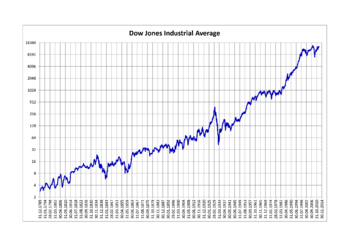Difference between revisions of "Dow Jones Industrial Average"
(Created page with "{{concept |type=economic |wikipedia=http://en.wikipedia.org/wiki/Dow_Jones_Industrial_Average }} {{SMWDocs}} ==References== <references/> {{stub}}") |
(unstub) |
||
| (3 intermediate revisions by 2 users not shown) | |||
| Line 1: | Line 1: | ||
{{concept | {{concept | ||
|type=economic | |type=economic | ||
| − | |wikipedia= | + | |image=Dow Jones Industrial Average.png |
| + | |image_width=350px | ||
| + | |start=1896 | ||
| + | |wikipedia=https://en.wikipedia.org/wiki/Dow_Jones_Industrial_Average | ||
| + | |website=http://www.djaverages.com/index.cfm?go=industrial-overview | ||
| + | |description=A purportedly neutral indicator of the state of the economy. | ||
}} | }} | ||
| + | The '''Dow Jones Industrial Average''' (DJIA), '''Dow Jones''', or simply the '''Dow''', is a price-weighted measurement stock market index of 30 prominent companies listed on stock exchanges in the United States. | ||
| + | |||
| + | It was created by [[Charles Dow]], the editor of The [[Wall Street Journal]] in [[1896]]. | ||
| + | |||
| + | ==Concerns== | ||
| + | Open to manipulation by very basic means - such as the choice of which shares are used to compile it. | ||
| + | |||
| + | [[Yves Smith]] from [[Naked Capitalism]] writes: "While the inclusion of the Dow Divisor may have seemed totally straightforward it was – and still is – anything but. Because every time the number of, or specific constituent, companies change in the index any comparison of the new index value with the old index value is impossible to make with any validity whatsoever. It is like comparing the taste of a cocktail of fruits when the number of different fruits and their distinctive flavours – keep changing."<ref name=Yves>https://www.nakedcapitalism.com/2014/05/the-dow-jones-industrial-average-is-a-hoax.html</ref> | ||
| + | |||
| + | In the 1990s many shares were split. To make sure the result of the calculation remained the same both the number of shares and the divider changed. An increase in share value of 1 dollar of the set of shares in 2014 results is 6.4 times more points than in 1985. The fact that in the 1990s many shares were split is probably the cause of the exponential growth of the Dow Jones index. Per [[2014]] the Dow was at 16,437 points. If we used the [[1985]] formula it would be at 2,559 points.<ref name=Yves/> | ||
| + | |||
| + | |||
| + | |||
{{SMWDocs}} | {{SMWDocs}} | ||
==References== | ==References== | ||
| − | <references/> | + | <references/> |
| − | |||
Latest revision as of 07:14, 28 November 2021
 | |
| Type | economic |
| Start | 1896 |
| Interest of | Wim Grommen |
| A purportedly neutral indicator of the state of the economy. | |
The Dow Jones Industrial Average (DJIA), Dow Jones, or simply the Dow, is a price-weighted measurement stock market index of 30 prominent companies listed on stock exchanges in the United States.
It was created by Charles Dow, the editor of The Wall Street Journal in 1896.
Concerns
Open to manipulation by very basic means - such as the choice of which shares are used to compile it.
Yves Smith from Naked Capitalism writes: "While the inclusion of the Dow Divisor may have seemed totally straightforward it was – and still is – anything but. Because every time the number of, or specific constituent, companies change in the index any comparison of the new index value with the old index value is impossible to make with any validity whatsoever. It is like comparing the taste of a cocktail of fruits when the number of different fruits and their distinctive flavours – keep changing."[1]
In the 1990s many shares were split. To make sure the result of the calculation remained the same both the number of shares and the divider changed. An increase in share value of 1 dollar of the set of shares in 2014 results is 6.4 times more points than in 1985. The fact that in the 1990s many shares were split is probably the cause of the exponential growth of the Dow Jones index. Per 2014 the Dow was at 16,437 points. If we used the 1985 formula it would be at 2,559 points.[1]
Related Document
| Title | Type | Publication date | Author(s) | Description |
|---|---|---|---|---|
| File:The Dow Jones Industrial Average - a fata morgana.pdf | article | 19 June 2014 | Wim Grommen | An examination of the mathematics of the Dow Jones. Does it say anything of value about the state of the economy or society? The author concludes that looking at the number of people in society that use food stamps would be a better measure, one that is not wide open to manipulation by the 1%. |